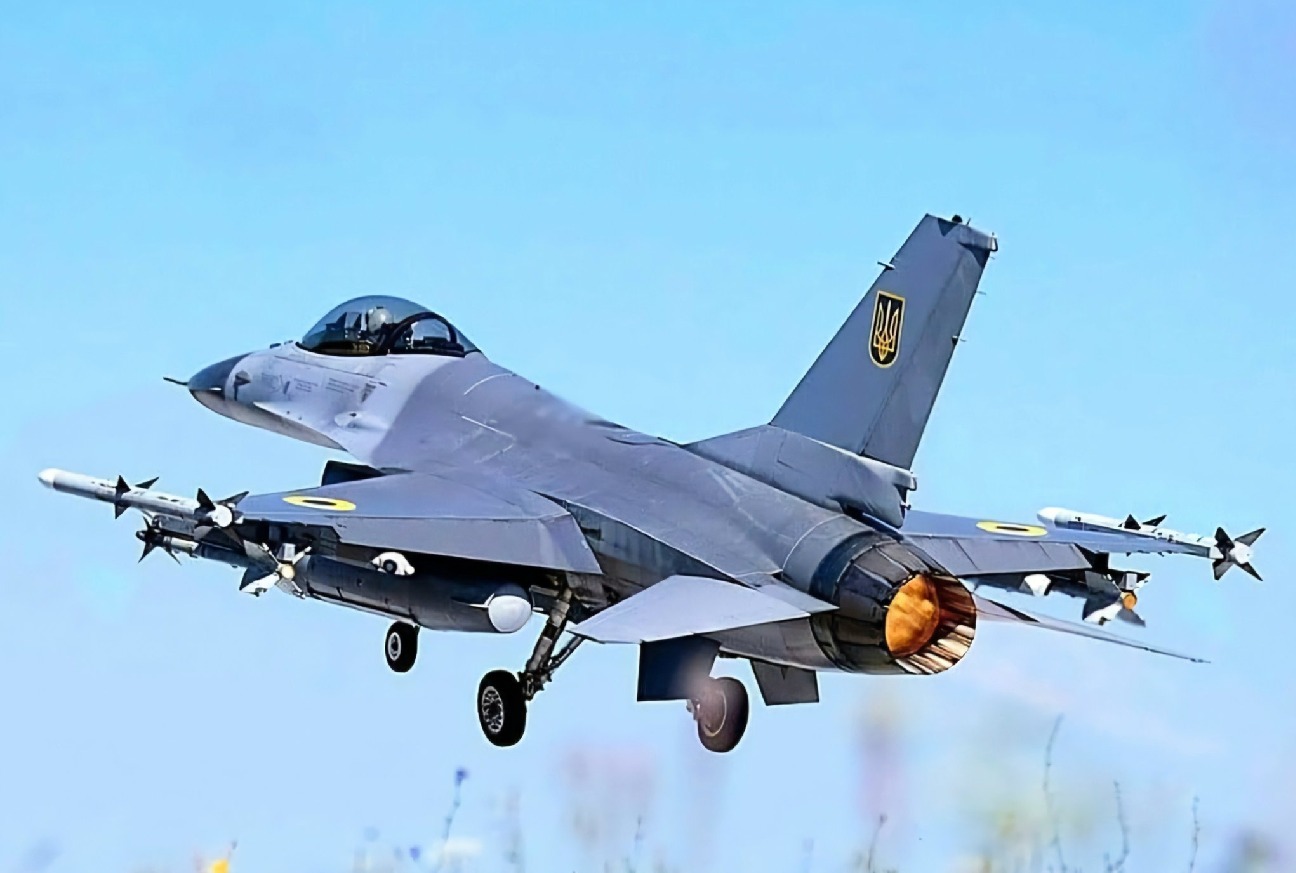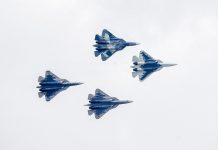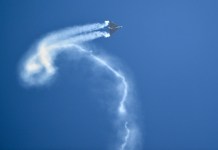A key US Air Force unit reprogrammed the electronic warfare (EW) system of the F-16 combat jets delivered to Ukraine, enhancing the protection of Fighting Falcons against contemporary and evolving Russian threats.
In early August, Ukraine received the first batch of F-16s from NATO partners.
“F-16s in Ukraine. We did it,” President Zelensky said at an unidentified base with two F-16s on his sides. These aircraft were observed equipped with a series of specialized pylons, indicating that they were outfitted with certain self-defense electronic warfare measures. However, that’s not the whole story.
The US Air Force (USAF) bolstered the EW capabilities of these combat aircraft. The 350th Spectrum Warfare Wing of the U.S. Air Force, which includes the 68th Electronic Warfare Squadron (EWS), spearheaded the reprogramming operation in coordination with its counterparts in Denmark and Norway, according to a press release published by the wing on August 26.
The service emphasized the importance of Electronic Warfare in the ongoing conflict in Ukraine, stating that both Russia’s and Ukraine’s armed forces rely heavily on unfettered access to the electromagnetic spectrum to achieve their objectives and have continuously employed EW tactics, such as spoofing and jamming, to obtain spectrum superiority.
“With the third-party transfer of F-16s by Denmark, Norway, and the Netherlands to Ukraine, another EW capability is joining the fight for Ukraine,” claimed the wing. In the upcoming years, Ukraine is expected to get about 91 F-16 AM/BMs from Denmark, the Netherlands, Belgium, and Norway combined.
The F-16’s EW subsystems needed to be reprogrammed for it to be used against changing Russian threats in the spectrum and be successfully integrated into the Ukrainian Air Force. The 68th EWS took this challenge head-on owing to the urgent priority accorded to it by the US and its allies.
In the high-stakes battlefield of electromagnetic spectrum operations (EMF), agility and quickness are paramount. Adversaries often employ jamming tactics to disrupt access to the electromagnetic spectrum, blocking crucial communications and navigation capabilities. Once a signal is identified, the forces have to work to reprogram the EW system to counter it. With the Ukrainian F-16s, this would be done in real combat.
The USAF did not disclose the exact nature of this modernized EW capability, but as of now, even the United States does not have this capability available in its service.
When asked what the reprogramming of the EW System means for the Ukrainian F-16s, IAF veteran Air Marshal Anil Chopra (retd) told EurAsian Times, “The reprogramming of the F-16 by the USAF is in favor of the United States and Ukraine. They need to safeguard their frequencies from Russia, which also makes use of advanced Electronic Intelligence tools. These tools record everything. The US has reprogrammed the F-16s EW system, so too much information does not fall into Russian hands.”
Air Marshal Chopra added that “the aircraft that are being sent to Ukraine are old jets that need to be upgraded. Washington is aware that upgrading the EW component would be more rewarding than, maybe, upgrading the radars. The US is not giving Ukrainian F-16s long-range weapons. They know these fighters will merely play a defensive role, so the focus is on bolstering defense and, thus, bolstering the electronic warfare capability.”
Air Marshal Chopra explained that the threat library of these archaic F-16s would have been updated with information on the latest Russian military systems deployed around 300 kilometers from the frontline. The US, like all other countries, maintains an electronic library. That information has to be fed into the EW system of the older F-16s. “Older systems were hard-wired, but the newer systems are software driven and modernized to keep up with the battlefield realities.”
The Ukrainians will also provide the US with data they get from actual conflicts to help enhance and expand the electronic warfare capabilities that both nations, as well as other friends and partners, have access to.

The Tedious Task Of Reprograming F-16’s EW
The 68th is part of the 350th Spectrum Warfare Wing of the U.S. Air Force, established in 2021 following a groundbreaking study on the electromagnetic spectrum aimed at revitalizing its use within the service. The wing’s three main tasks are quick reprogramming, developing targets and waveforms, and evaluating the Air Force’s electronic warfare capabilities.
Under the direction of the 68th Electronic Warfare Squadron, the USAF specialists had to learn a new EW system and then optimize it using information from Denmark and Norway, which required a significant level of flexibility in their work.
The 68th EW encountered two challenges: first, the system for the F-16s that were about to be delivered was not available in the United States inventory, and second, there was a pressing deadline to optimize these EW systems to meet the aircraft’s delivery schedule.
“Most reprogramming centers would have said ‘no way’ when approaching this challenge; it’s uncharted policy,” said the 68th EWS chief engineer, whose identity was not disclosed in the release. “We looked at each other, and we said, ‘If not us, then who? We’re the best people to do this.”
Russia Finally Finds Counter To HIMARS Shoot & Scoot Capability; RuMoD Says 2 Launchers Destroyed
The 68th EWS put together a committed team to take on the reprogramming task, consisting of both young, talented engineers and seasoned pros. The first thing they had to do was learn how to reprogram the unfamiliar EW system.

According to the Air Force, new procedures and methods were devised to comprehend and reprogram the F-16’s EW system to defend against Russian threats. The upgraded system was then tested with “coalition teammates” in a “partner-nation lab.” The team’s stated goal was to test and verify the unique elements required by the Ukrainians.
The team comprehended the system and got to work by using data from Denmark and Norway and then modifying new procedures and methods to the standard procedure. Once the 68th EWS had a better knowledge of the system, it strayed from protocol, sending members of the unit to a partner nation’s facility to work together to build and test the system with coalition allies.
“This is not our standard operating procedure,” said the 68th EWS director, whose identity was also obscured. “The fact that the team was able to figure out the system in two weeks, go in the country with a partner to develop a best-ever mission data file is unheard of and is thanks to the talent here in the squadron and the wing.”
The development occurs despite officials and analysts voicing concerns about the F-16, noting that the aircraft is unlikely to be a quick fix for conducting offensive operations or targeting Russian jets. Instead, the F-16 would be used for air defense roles, thwarting Russian drone and missile attacks that endanger its civilian infrastructure. The addition of a reprogrammed EW system would enhance the capability and survivability of these F-16s going ahead.
“When you’re talking about a near-peer conflict, you need all of your coalition partners to operate with the same playbook so you can achieve spectrum dominance,” said the 68th EWS director. “One F-16 with a reprogrammed pod won’t achieve air dominance alone, but it may give you a pocket of air superiority for a moment to achieve an objective with strategic importance and impact.”
The USAF’s reprogramming of its electronic warfare systems won’t make it invincible against all threats. Nevertheless, given that the Ukrainian Air Force operates in one of the densest, most active air defense settings in the world, it may provide a vital survival advantage. This will better equip the US and its allies to handle potential future contingencies.
- Contact the author at sakshi.tiwari9555 (at) gmail.com
- Follow EurAsian Times on Google News




